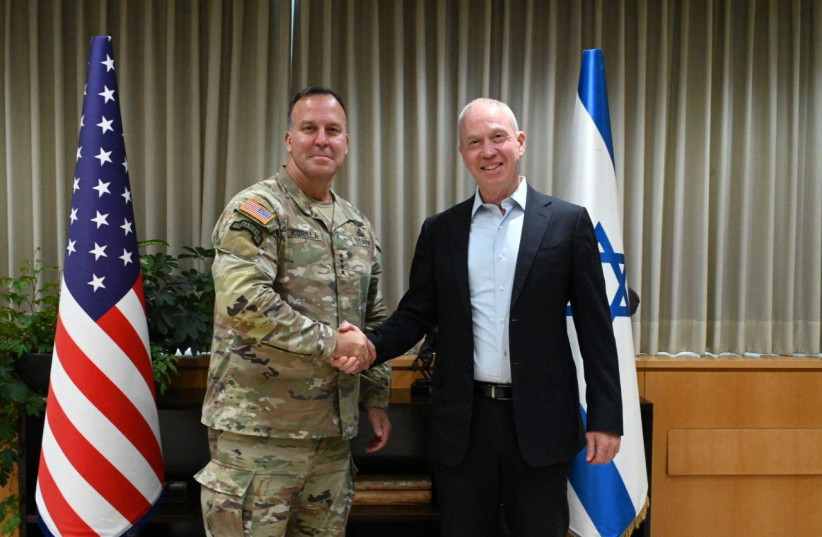What does joint US, Israel military planning mean regarding Iran? – analysis
Usually any time the US offers Israel more military aid, joint exercises and coordination, Israel jumps at the offer.
Jerusalem has been careful to highlight a variety of recent joint military exercises, including a joint aircraft exercise in early January, the giant Juniper Oak exercise in later January and the Red Flag joint exercise in March.
Also, Israel has highlighted separate visits by US Secretary of Defense Lloyd Austin and US military chief Gen. Mark Milley in March and a visit by CENTCOM Chief Gen. Michael Kurilla in late April.
 Defense MinisterYoav Gallant and US CENTCOM Chief General Michael Kurilla. (credit: ARIEL HERMONI/DEFENSE MINISTRY)
Defense MinisterYoav Gallant and US CENTCOM Chief General Michael Kurilla. (credit: ARIEL HERMONI/DEFENSE MINISTRY)The idea is usually to send a message to Iran that Israel has the US’s backing, if necessary, for military action against the Islamic Republic, and possibly even some readiness by the US to participate on some level in assisting Israel directly with such an action.
With that in mind, what is the best way to understand the complex report that came out on Wednesday from Axios that some of these trips have involved American officials seeking to deepen sharing of operational planning against Iran – only to be rebuffed by Israel?
First, we need to keep in mind that all of the US and Israeli comments about this exchange are part of a three-dimensional chess game that all sides are playing with each other and with Tehran.
The US wants to alternately make Israel feel safe by showing it is serious about military cooperation, but also wants to discourage the Jewish state from actually using force against the ayatollah’s nuclear program anytime earlier than the Biden administration would view it as necessary.
What is the difference between the point in time Israel would think a preemptive strike on Iran’s nuclear program would be necessary versus America’s timeline?
Recently, former IDF intelligence chief Tamir Hayman told the Jerusalem Post that Israel needed to keep an eye on top Iranian atomic officials’ leanings – a bottom-up focus – and not just look at Supreme Leader Ayatollah Ali Khamenei. If they started to push for moving toward an actual nuclear weapon – as opposed to just building significant amounts of enriched uranium stock but not crossing the nuclear threshold – Jerusalem might worry.
Put more simply, Israel might strike at some moment than it sees signs Iran is moving toward a nuclear weapon, even if the moment of crossing the threshold might be months away.
In contrast, the US might wait much later – until a mere days or weeks before Iran might be capable of using a nuclear weapon before acting, or wanting Israel to act.
This is an oversimplification because there are always a million factors in play with major decisions about war and peace, including any last possible attempts at diplomacy with Iran which might open up with a more imminent military threat, relations between Tehran and the IAEA inspectors, domestic politics and the overall geopolitical balance between the world’s major powers.
The Pentagon provided the Post with the same on-record response which it gave Axios, “Senior leaders at the Department have made repeated public statements regarding our interest in expanding military cooperation with the Israeli Defense Forces, to include by increasing joint participation in military training exercises in order to improve interoperability and promote a common understanding of regional security challenges. The relationship between the U.S. and Israeli militaries is extremely close, and our commitment to Israel’s security remains ironclad.”
Nothing in this statement really clarifies whether the US offer would grant Israel new advantages or come with new strings, though US officials do seem to want to make pains to not want to be perceived as attaching strings.
There is another possibility. The Biden administration pretty much conveyed to a group of US Senators on Wednesday that it is treading water with the Islamic Republic without any real idea of how to exit the current stalemate.
This latest proposal to Israel may not be a one-sided give Israel more military backing or an opposite one-sided attempt to restrain Jerusalem. It could also be a play at figuring out how Israel is perceiving the current stalemate and what direction it might go in the coming months.
Such a test would not set any new clear change in policy for either country as much as it might help the US decide on what its policy should be if Iran continues to march its nuclear program forward both without crossing the nuclear threshold and without any nuclear deal.
The IAEA Board of Governors meets in two-and-a-half weeks and will need to decide again whether to refer Tehran to the UN Security Council or punt the issue once more.
In that light, maybe all of this is just the opening act before the next real round of decisions.





Comments are closed.